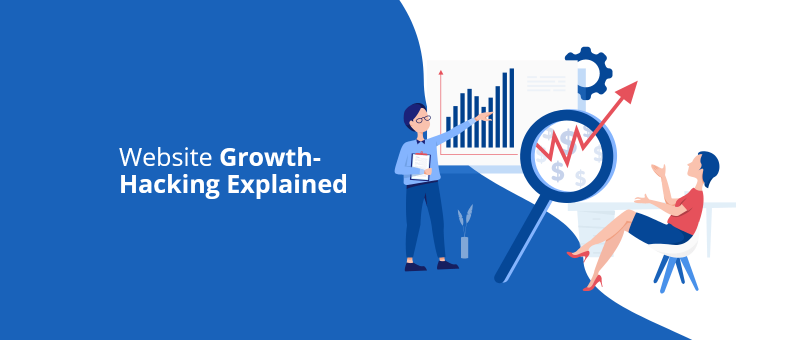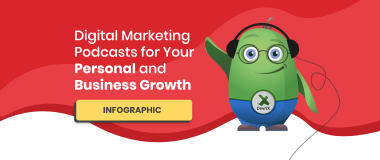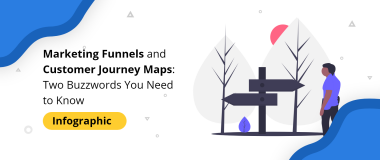Creating a website and growing a successful business on top of it are two drastically different things. When you’re just starting to promote your brand and establishing your business, launching a website is exciting.
But, as soon as you realize you need to scale your operations, you realize that your website is the core of your strategy. Here you should either invest in the site to make it a sales machine or forget about ROI like numerous other companies that have taken their online presence for granted.
What Is Growth-Hacking?
If you haven’t heard the term ‘Growth Hacking’ yet, let’s begin by saying that it’s not just a buzzword. It’s the principle of working towards growth, involving every aspect of your work process, your online marketing strategy, and your website.
Growth hacking aims to find short-cuts, fast and original ways to succeed in online business. It combines an intuitive approach to analytics, testing innovative business tactics, and customer acquisition strategies to improve your bottom line.
The AARRR Principle
If you’ve just started experimenting with scaling, some people have already set down the right framework for you. One of them is Dave McClure – an investor and the founder of 500 Startups. In 2007, he coined an unusual growth-hacking method for startups called AARRR aka the Pirate Metrics.

Originally designed for startups, the AARRR is an excellent system to apply to WordPress growth-hacking, too. It covers the complete online user journey.
Applied to online business, the acronym AARRR stands for:
- Acquisition: Acquiring new users for the site
- Activation: Engaging users to interact
- Retention: Nurturing leads and retaining customers
- Revenue: Users conduct some monetization behavior
- Referral: Stimulate users to recommend your product/service
All you have to do is figure out the actions that you will use at each stage, experiment, and measure to find quick improvement opportunities.
Have you read – 15 Lead Nurturing Ideas for Each Stage of the Buyer Journey?
1. Acquisition Stage
The acquisition stage is where you need to bring more targeted traffic to your site, implementing a lot of inbound and outbound tactics.
In the battle for users’ attention, you must be inventive with your content and provide as much value as possible. A technique that can work wonders for your WordPress website growth is the Skyscraper content method, coined by Backlinko himself.
It is an inbound marketing approach that revolves around researching content topics that perform well within the user base and search engines. It also includes backlinking to current related posts aimed at similar target audiences.
Here’s how you can implement this content strategy to attract more leads:
- Find Popular Topics – Look for content that performs well on SERPs and social media shares.
Here are some tools that can help you with this step: BuzzSumo, SEMRush, Google Alerts, Moz Open Site Explorer. - Create Better Content – The idea here is to ensure that your content is better than the competition.
- Provide a Unique Angle – What can you do to set yourself apart? Establish yourself in the industry with a unique angle and using insight from your own experience.
2. Activation Stage
Activation is the moment when users can use your WordPress website to its fullest potential. At this stage, your job is to make them happy, provide flawless UX, and help them understand the benefits they’ll get from your service/product.
When customers are activated, they’re taking the first steps towards buying your product/service. So, what sort of tools and content can help you boost the activation rate on your WordPress site?
Here are some proven strategies to support activation and use engagement on your site:
- Homepage Elements – This is the page that gets visited the most. As there is no second chance for a first impression, make sure the homepage includes a summary of the most important messages, content and conversion tools for your audiences
11 Essential Tips to Building a Lead Generating B2B Homepage
- Your UVP and Copy – Make your Unique Value Proposition visible on the homepage. It should be above the fold and display the benefits you offer.
- Call-to-Action buttons and Lead Acquisition Forms – These are the interactive tools that will convert users to leads, so plan them out wisely across the whole user experience map.
- Blog and Resources – When you have created good content to attract users and rank better on search engines, it should be accessible on your homepage.
- Relevant Landing Pages – Support your ad campaigns across social media and on other relevant channels. Link relevant landing pages on your site to complete the campaigns’ messages and convert traffic.
9 Tips in Creating a Landing Page for Your Marketing Campaign
- Animations, Pop-Ups, Live Chats – These are popular ways to attract attention and require user actions. Experiment with them but try not to overdo it. Nobody likes to be interrupted while surfing online.
3. Retention Stage
The key to a thriving business is not to ignore your loyal customers while acquiring new ones. Remember that the customer-business relationship does not end with a sale. It is also more expensive to attract and convert new users than to keep your current clients.
Your customer retention rate will inform you of exactly how many of your current clients appreciate what you provide. A bad retention rate may be a serious signal that your services and/or products are not good enough. Therefore, scaling your business will be very hard.
Here’s how you can growth-hack your WordPress website through customer retention:
Timely Customer Support
When users are treated badly, they leave – 52% of customers have switched brands because of bad customer experience. To prevent churn, the customer support experience must be impeccable.
With WordPress, you can integrate useful customer support plugins such as web forms, live chat, interactive FAQ sections, or automated email. These are all convenient ways to allow customers to ask a question or for assistance.

Quality and timely support retain and increase the number of clients. Source: Zoom
Reward Loyalty
Developing and promoting loyalty programs is an excellent way to retain customers. You can set up different loyalty programs, such as:
- Points System: Every time someone buys from your website, they gain a certain number of points. The more they buy, the more points they get.
- The Tier Plan: The more loyal your customers are, the higher the reward is for them. Each new purchase means a better and improved reward.

Loyalty program “Flying Club” section by Virgin Atlantic
To motivate customers to buy more from you and create a sense of urgency around your product/s, here’s what you can do:
- Promote Your Loyalty Program: Don’t hide the rewards. Ensure that your first-time customers notice it immediately through a pop-up.
- Ask and Reward Feedback: Any feedback from your customers should be welcomed. You also should be actively asking for it. It’s a sign that you want to keep your customers happy.
- Send Recommendation Emails: The inbox is the place where you can convince customers to return to the fold. You just need the right email and an irresistible offer that is complementary to the product/service that they’re currently using.
4. Revenue Stage
Revenue – Every business aims to make a profit. From the moment your website is live, you’ll want to follow qualified leads, make sales and put your website out there. Find how to calculate the ROI of your website and use growth-hacking opportunities to improve your bottom line.
The most effective way to growth-hack your revenue is to keep a 3:1 ratio between the CLV (Customer Lifetime Value) and CAC (Customer Acquisition Cost).
What Your Technology Website Needs to Convert Leads Like a Revenue Machine
5. Referral Stage
Referrals are perhaps the most cost-effective and authentic way to growth-hack the number of users.
Referral Programs reward customers who bring you more business. If your business is based entirely online, creating customer referrals programs, and tracking them is much easier than with physical product sales.
As soon as you attract and acquire the right users for your product/service, you need to start asking them for feedback. Collecting feedback matters. It allows you to better understand users, provide better services, and ensure customer retention, which ultimately results in revenue growth.
When customers refer to your service, it means that they trust you and want others to know about the benefits that you provide.
Wrapping Up
If you are just starting with growth-hacking tactics, you’ll need to study each of the stages mentioned above and focus on the AARRR metrics as well. After that, you’ll need to experiment, get timely feedback and optimize each stage of the journey.
If you want to learn more about growth-hacking WordPress websites and how to scale them, don’t hesitate to let us know by leaving a comment below or getting in touch with our team.




